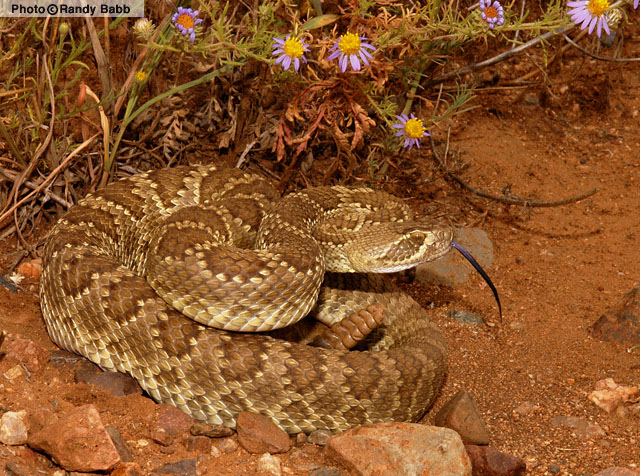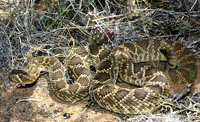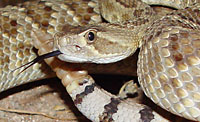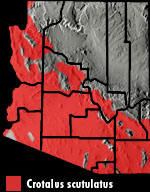Online Field Guide to The Reptiles and Amphibians of Arizona



Cochise County, AZ
 Coconino Co., AZ |
| MOHAVE RATTLESNAKE Crotalus scutulatus |
Venomous
|
| DESCRIPTION: A large (up to 1,270 mm or 50″ in total length excluding rattle), tan, olive, or gray-brown rattlesnake with a series of dark blotches running down the back. The blotches have dark edges and uniform brown, dark gray, or olive-brown centers. As they near the tail the blotches gradually morph into cross bands. The tail is often pale gray with black, dark gray, or gray-brown rings that are narrower than the space between them. A thin, light colored stripe extends back from the posterior corner of the eye to beyond the corner of the mouth. The pupils are vertically elliptical and the dorsal scales are keeled. The base of the tongue is purple. The neck is slender and the head is broad and triangular. On the end of the tail is a rattle composed of a series of loosely interlocking keratinous sections. A new section is added each time the snake sheds its skin. The angle of this snakes eye-stripe, its uniformly-colored blotches, and its relatively thin tail rings distinguish it from the similar looking Western Diamond-backed Rattlesnake.
DISTRIBUTION: This snake is found across most of western and southern Arizona at elevations ranging from near sea level along the Colorado River to over 5,200′. HABITAT: It occurs in Sonoran, Mohave, and Chihuahuan desertscrubs and Semidesert Grassland. In a few Arizona localities it enters the lower reaches of Plains and Great Basin Grassland communities. It is usually found below the steep slopes in relatively level terrain such as creosotebush flats, low valleys, gently sloping bajadas, and rolling foothills.BEHAVIOR: It is primarily nocturnal across most of its range in Arizona. It is nocturnal and crepuscular in areas with more moderate daytime temperatures (such as southeastern Arizona). It hibernates during the cold months of late fall and winter. When threatened this snake sometimes exhibits a dramatic defensive display that includes incessant rattling, elevating the head into a high striking posture, frequent striking, and a gradual retreat toward the nearest shelter. Like the other “pit-vipers” (members of the subfamily Crotalinae) this snake uses heat sensing pits (one on each side of the face between the eye and nostril) to detect warm-blooded predators and prey.DIET: The Mohave Rattlesnake feeds on rats, mice, lizards, birds, and frogs. It uses venom injected through long, hollow, retractable fangs to kill and begin digesting its prey.REPRODUCTION: Mating takes place in spring and summer. A litter of up to 17 young is born in summer. REMARKS: This rattlesnake is capable of delivering large amounts of potent venom. In some parts of the state its venom contains dangerous neurotoxins. If encountered it should be left alone. A large percentage of envenomations occur when a snake is handled or abused.By Thomas C. Brennan Bartlett. 2000. Snakes of North America: Western Region. Gulf Publishing Co. Houston, TX Brennan, T. C., and A. T. Holycross. 2006. A Field Guide to Amphibians and Reptiles in Arizona. Arizona Game and Fish Department. Phoenix, AZ Brennan, T. C., and A. T. Holycross. 2005. A Field Guide to Amphibians and Reptiles of Maricopa County. Arizona Game and Fish Department. Phoenix, AZ Degenhardt, W. G., Painter, C. W., and Price, A. H.. 1996. Amphibians and Reptiles of New Mexico. University of New Mexico Press. Albuquerque. Fowlie. 1965. The Snakes of Arizona. Azul Quinta Press, Fallbrook, California Lowe, Schwalbe, Johnson. 1986. The Venomous Reptiles of Arizona. Nongame Branch Stebbins. 1985. Western Reptiles and Amphibians. Houghton Mifflin. New York, |
|
Visit Partners in Amphibian and Reptile Conservation:


HOME
Copyright © 2023, Arizona Game and Fish Department. All rights reserved.
If you make use of the textual contents of this site in reports, publications, etc. please cite and credit the author(s) and photographer(s). All photos on this website are copyrighted. However, those found in the species account section may be used for any noncommercial scientific, educational, or conservation purposes provided that photographs are not altered and continue to bear the copyright symbol and name of the photographer. Please contact the photographer regarding commercial use of copyrighted photographs.











